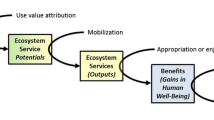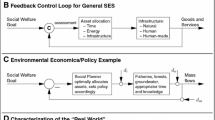Abstract
Predicting environmental change and its impacts on ecosystem goods and services at local to global scales remains a significant challenge for the international scientific community. This is due largely to the fact that the Earth is made up of open, coupled, complex, interactive and non-linear dynamic systems that are inherently unpredictable. Uncertainties over interactions and feedbacks between natural and human drivers of environmental change (operating at different spatial and temporal scales) can compound intrinsic intractable difficulties faced by plural societies aiming at sustainable management of ecosystems. Social-Ecological Systems (SES) theory addresses these strongly coupled and complex characteristics of social and ecological systems. It can provide a useful framework for articulating contrasting drivers and pressures on ecosystems and associated service provision, spanning different temporalities and provenances. Here, system vulnerabilities (defined as exposure to threats affecting ability of an SES to cope in delivering relevant functions), can arise from both endogenous and exogenous factors across multiple time-scales. Vulnerabilities may also take contrasting forms, ranging from transient shocks or disruptions, through to chronic or enduring pressures. Recognising these diverse conditions, four distinct dynamic properties emerge (resilience, stability, durability and robustness), under which it is possible to maintain system function and, hence, achieve sustainability.




Similar content being viewed by others
References
Acheson JM (2006) Institutional failure in resource management. Ann Rev Anthropol 35:117–134
Adger WN (2006) Vulnerability. Global Environ Change 16(3):268–281
Bascompte J, Melia CJ, Sala E (2005) Interaction strength combinations and the overfishing of a marine food web. Proc Natl Acad Sci 102:5443–5447
Beddington JR, Agnew DJ, Clark CW (2007) Current problems in the management of marine fisheries. Science 316:1713–1716
Berkes F, Folke C (eds) (1998) Linking social ecological systems: management practices and social mechanisms for building resilience. Cambridge University press, Cambridge
Berkes F, Colding JF, Folke C (2003) Navigating nature’s dynamics: building resilience for complexity and change. Cambridge University Press, New York
Brookes N, Adger WN, Kelly PM (2005) The determinants of vulnerability and adaptive capacity at the national level and the implications for adaptation. Global Environmental Change 15:151–163
Burgess N, Ward D, Hobbs R, Bellamy D (1995) Reedbeds, fens and acid bogs. In: Sutherland WJ, Hill DA (eds) Managing habitats for conservation. Cambridge University Press, Cambridge, pp 149–196
Carpenter SR (2003) Regime shifts in lake ecosystems: pattern and variation. Excellence in Ecology Series, vol 15. Ecology Institute, Oldendorf/Luhe, Germany
Corning PA (2002) The re-emergence of “Emergence”: a venerable concept in search of a theory. Complexity 7(6):18–30
Côté SD, Rooney TP, Tremblay J-P, Dussault C, Waller DM (2004) Ecological impacts of deer overabundance. Annu Rev Ecol Evol Syst 35:113–147
Cumming GS, Cumming DHM and Redman CL (2006) Scale mismatches in social-ecological systems: causes, consequences, and solutions. Ecol Soc 11(1):14. Available online at http://www.ecologyandsociety.org/vol11/iss1/art14/
EEA (1995) Europe’s environment: the dobris assessment. European Environment Agency, Copenhagen
EEA (1999) Environmental indicators: typology and overview. Technical report No. 25. European Environment Agency, Copenhagen
Estes JA, Palmisano JF (1974) Sea-otters: their role in structuring nearshore communities. Science 185:1058–1060
Feld CK, Sousa JP, Martins da Silva P, Dawson TP (2010) A framework for improved biodiversity and ecosystem services’ assessment in future ecosystems indication. Biodiversity and Conservation (this volume, in press)
Frantzeskaki N, Thissen W (2009) Institutional architectures for social-ecological systems governance towards sustainability. Proceedings, conference on the human dimensions of global environmental change, 2–4 December 2009, Amsterdam, The Netherlands
Fusco G (2001) Conceptual modelling of the interaction between transportation, land use and the environment as a tool for selecting sustainability indicators of urban mobility, 12th European colloquium on quantitative and theoretical geography, St-Valery-en-Caux, France, 7–11 September 2001
Galaz V, Hahn T, Olsson P, Folke C, Svedin U (2007) The problem of fit between ecosystems and governance systems: insights and emerging challenges. In: Young O, King LA, Schroeder H (eds) The institutional dimensions of global environmental change: principal findings and future directions. MIT Press, Boston
Gallopin GC (2006) Linkages between vulnerability, resilience, and adaptive capacity. Global Environ Change 16:293–303
Gatzweiler F, Hagedorn K (2002) The evolution of institutions in transition. Int J Agric Resour Governance Ecol 2(1):37–58
Graham MH (2004) Effects of local deforestation on the diversity and structure of Southern California giant kelp forest food webs. Ecosystems 7:341–357
Gunderson LH, Holling CS (eds) (2002) Panarchy: understanding transformations in human and natural systems. Island Press, Washington, DC
Hardin G (1968) The tragedy of the commons. Science 162:1243–1248
Holling CS (1973) Resilience and stability of ecological systems. Annu Rev Ecol Syst 4:1–23
Holling CS (1992) Cross scale morphology, geometry and dynamics of ecosystems. Ecol Monogr 62:447–502
Hougner C, Colding J, Söderqvist T (2006) Economic valuation of a seed dispersal service in the Stockholm National Urban Park, Sweden. Ecol Econ 59(3):364–374
Jones CG, Lawton JH, Shachak M (1994) Organisms as ecosystem engineers. Oikos 69:373–386
Jones CG, Lawton JH, Shachak M (1997) Positive and negative effects of organisms as physical ecosystem engineers. Ecology 78:1946–1957
Kauffman SA (1993) The origins of order: self-organization and selection in evolution. Oxford University Press, New York
Kinzi AP, Ryan P, Etienne M, Allyson H, Elmqvist T, Walker BH (2006) Resilience and regime shifts: assessing cascading effects. Ecol Soc 11(1):20. Available online at http://www.ecologyandsociety.org/vol11/iss1/art20/
Leach M, Scoones I, Stirling A (2009) Governing epidemics in an age of complexity: narratives, politics and pathways to Sustainability. Global Environ Change (in press, doi:10.1016/j.gloenvcha.2009.11.008)
Lenski RE, Barrick JE, Ofria C (2006) Balancing robustness and evolvability. PLoS Biol 4:e428
MEA. Millenium Ecosystem Assessment (2005) Ecosystems and human well-being : current state and trends: findings of the Condition and Trends Working Group. In: Hassan R, Scholes R, Ash N (eds) Millenium ecosystem assessment. Available online at http://www.millenniumassessment.org/en/index.aspx
Ostrom E (2009) A general framework for analyzing sustainability of social-ecological systems. Science 325:419–422
Rammel C, Stagl S, Wilfing H (2007) Managing complex adaptive systems—a co-evolutionary perspective on natural resource management. Ecol Econ 63:9–21
Richter BD, Mathews R, Harrison DL, Wigington R (2003) Ecologically sustainable water management: managing river flows for ecological integrity. Ecol Appl 13:206–224
Rounsevell MDA, Dawson TP, Harrison PA (2010) A conceptual framework to assess the effects of environmental change on ecosystem services. Biodivers Conserv (this volume, in press)
Scheffer M, Carpenter SR, Foley J, Folke C, Walker BH (2001) Catastrophic shifts in ecosystems. Nature 413:591–596
Scoones I, Leach M, Smith A, Stagl S, Stirling A, Thompson J (2007) Dynamic systems and the challenge of sustainability. Working Paper 1 for the ESRC centre for social, technological and environmental pathways to sustainability (STEPS), Brighton: June 2007
Smit B, Wandel J (2006) Adaptation, adaptive capacity and vulneability. Global Environ Change 16(3):282–292
Smit B, Burton I, Klein RJT, Street R (1999) The science of adaptation: a framework for assessment. Mitig Adapt Strat Glob Change 4:199–213
Stirling A (2007) Resilience, robustness, diversity: dynamic strategies for sustainability. Abstracts, 7th International Conference of the European Society for Ecological Economics. Leipzig, Germany, 5–8 June 2007
Stirling A (2008a) Strategies to address intractability in governance for sustainability. Conference of Resilience Alliance: Resilience 2008. Stockholm, 14 April 2008
Stirling A (2008b) The Dynamics of Sustainability: durability, stability, resilience and robustness. Environment Agency workshop on ‘Complexity economics for sustainability’. Centre for Continuing Education, University of Oxford, 28 November 2008
UN (2005) 2005 World summit outcome. Resolution A/60/1, adopted by the United Nations General Assembly on 15 September 2005. http://www.un.org/summit2005/documents.html. Accessed on 29 June 2010
Waldrop MM (1994) Complexity: the emerging science at the edge of order and chaos. Penguin, Harmondsworth, UK
WCED (1987) Our common future. Report of the world commission on environment and development. Oxford University Press, Oxford, UK. ISBN 0-19-282080-X
Acknowledgements
This work has been supported by the European Commission FP 6 Coordination Action Project RUBICODE (Rationalising Biodiversity Conservation in Dynamic Ecosystems) under contract number 036890, see www.rubicode.net. RUBICODE is an endorsed project of the Global Land Project of the IGBP. The authors are indebted to their colleagues in the RUBICODE project for their valuable contribution in framing the concepts outlined in the paper. Tatiana Kluvankova-Oravska and Veronika Chobotova acknowledge the support of the Slovak Academy of Sciences (CETIP -IF SAS) and the SPECTRA Centre of Excellence financed under the European Fund for Regional Development.
Author information
Authors and Affiliations
Corresponding author
Rights and permissions
About this article
Cite this article
Dawson, T.P., Rounsevell, M.D.A., Kluvánková-Oravská, T. et al. Dynamic properties of complex adaptive ecosystems: implications for the sustainability of service provision. Biodivers Conserv 19, 2843–2853 (2010). https://doi.org/10.1007/s10531-010-9892-z
Received:
Accepted:
Published:
Issue Date:
DOI: https://doi.org/10.1007/s10531-010-9892-z




